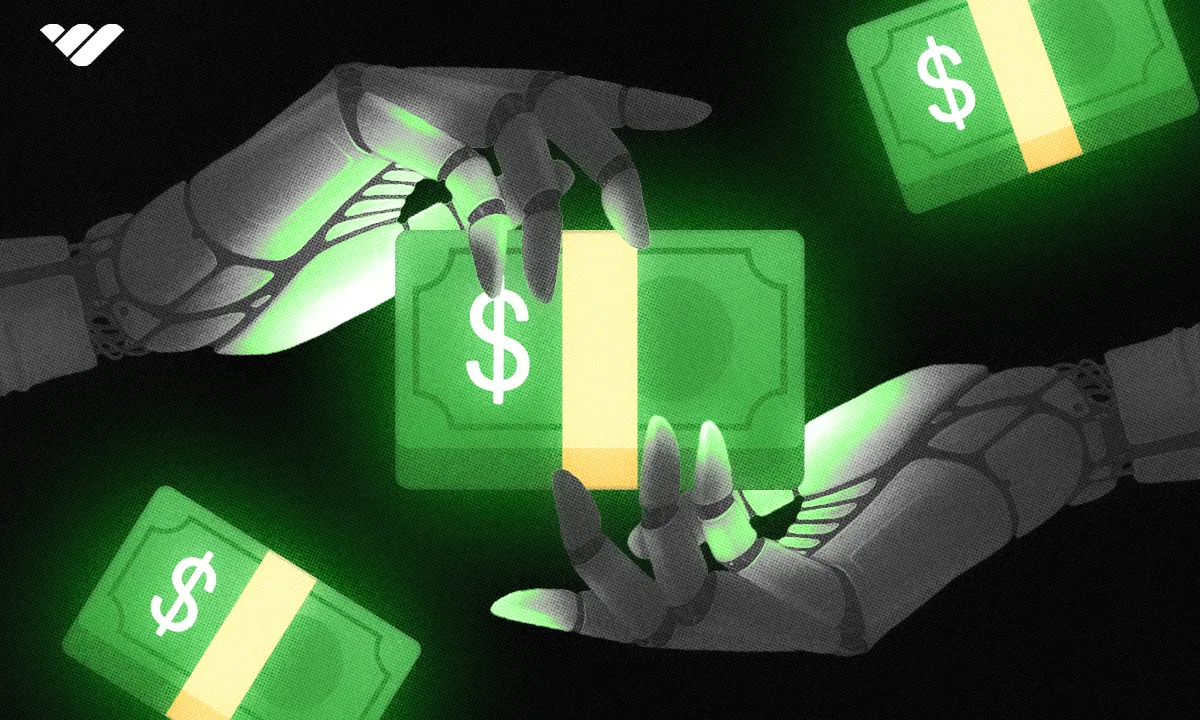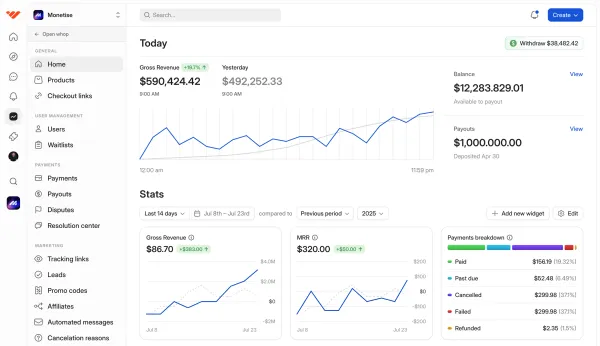Explore the most profitable AI side hustles, from creating digital printables to offering AI services. Find out how you can leverage AI tools to build new income streams.
Key takeaways
- Early AI adopters are already earning significant income through various AI-powered business models.
- Prompt engineering skills can earn $5-100,000+ monthly through marketplaces or business consulting.
- AI consultants command over $100,000 per month helping companies implement AI workflows.
- Print-on-demand businesses use AI to create profitable designs without artistic skills.
- AI coding tools help developers work faster but require human oversight for security.
AI is one of the biggest tech game-changers that we have seen in years, and it's showing no signs of slowing down.
While there is a lot of talk about the legit concerns of AI usage (like copyright issues and people letting it run wild), there's also a huge upside to this technology.
One upside? The huge earning potential that AI brings.
Early adopters are already cashing in, and if you’re not looking into how to use AI to your advantage, then you’re sleeping on serious potential.
So, how do you actually make money with AI? And what kinds of business models are out there waiting for you?
Let’s get into it.
Wondering how to make money with AI?
One of the best (and most stable) ways to make money with AI is to actually work in the industry.
The earning potential here can be huge. If you’ve got the skills, full-time roles in AI are seriously worth chasing.
But if you don't have what it takes to be a coder or engineer, don't worry. You can still make bank with AI. In fact, some AI side hustles are turning out to be more profitable than traditional tech jobs.
Across the word, smart entrepreneurs are using AI to work faster, smarter, and cheaper. They’re not building everything from scratch—they’re using AI to do the heavy lifting.
But the real secret to making money with AI lies in human creativity. You bring the ideas, and let AI bring them to life.
With the right prompts and tools, you can launch projects in minutes and start making money online.
Discover the best AI courses and communities online to level up your skills or start an AI business.
21 AI side hustle ideas
There are plenty of side hustles you can build and monetize with AI — like digital products, content creation, automated services, and more.
Here are some of the best.
1. Prompt engineering
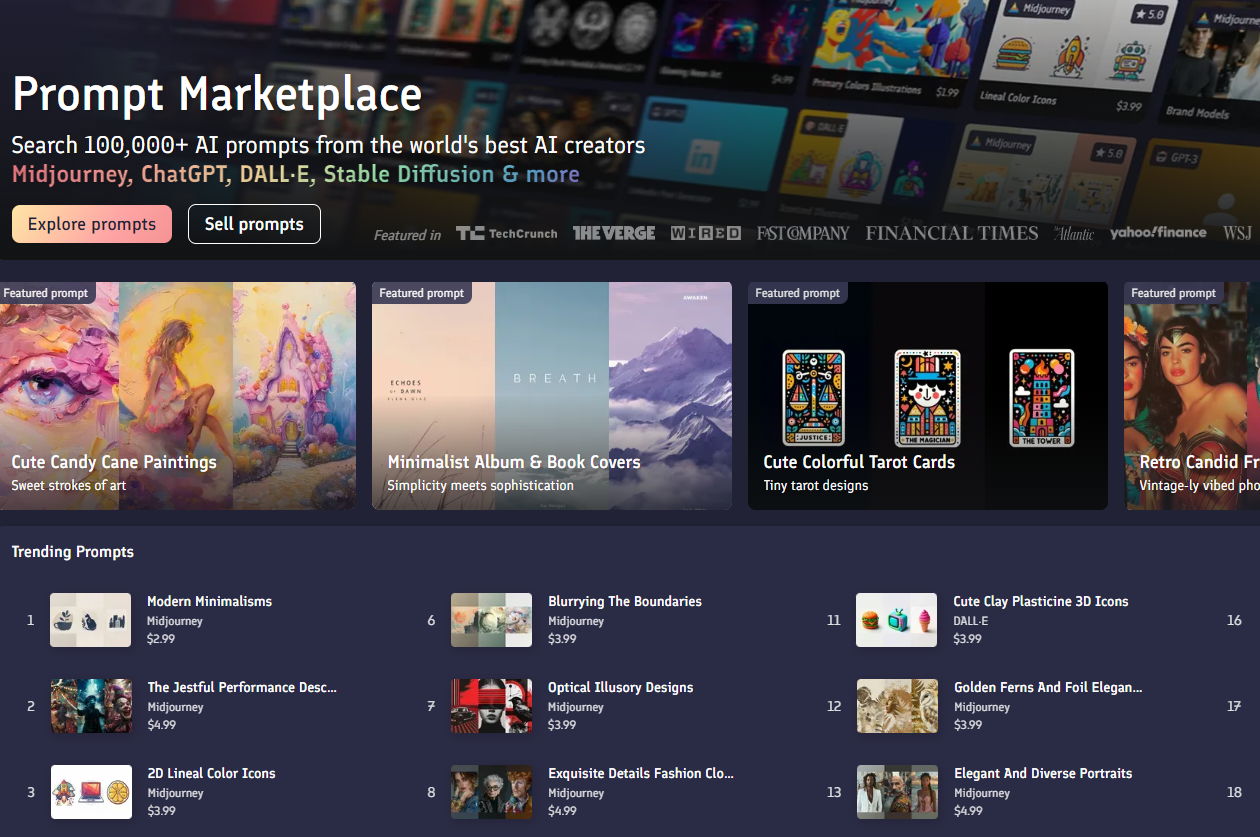
Using generative AI tools is basically about learning how to talk to them.
Tools like ChatGPT or Midjourney work by responding to the prompts that you give them. The better your prompts, the better the results.
Getting it right takes a bit of trial, error, and digging around to see what works. But once you've played around and learned how to prompt like a pro, you’ve got a seriously valuable skill that’s in demand.
With your new-found skill in prompt engineering, you can either look to monetize your prompts on prompt marketplaces or sell your skills to AI-positive companies.
What you need: Generative AI tools like ChatGPT, Stable Diffusion, DALL-E and Midjourney.
How to make money: Sell prompts on marketplaces or freelance for different types of businesses.
How much you can make: Simple prompts can go for around $5 per sale, but you can also look to sell complex, industry-specific prompts to businesses for a lot more.
- ChatGPT custom instructions explained – what they are, how they work
- Tips to help you improve your ChatGPT prompts
2. AI services
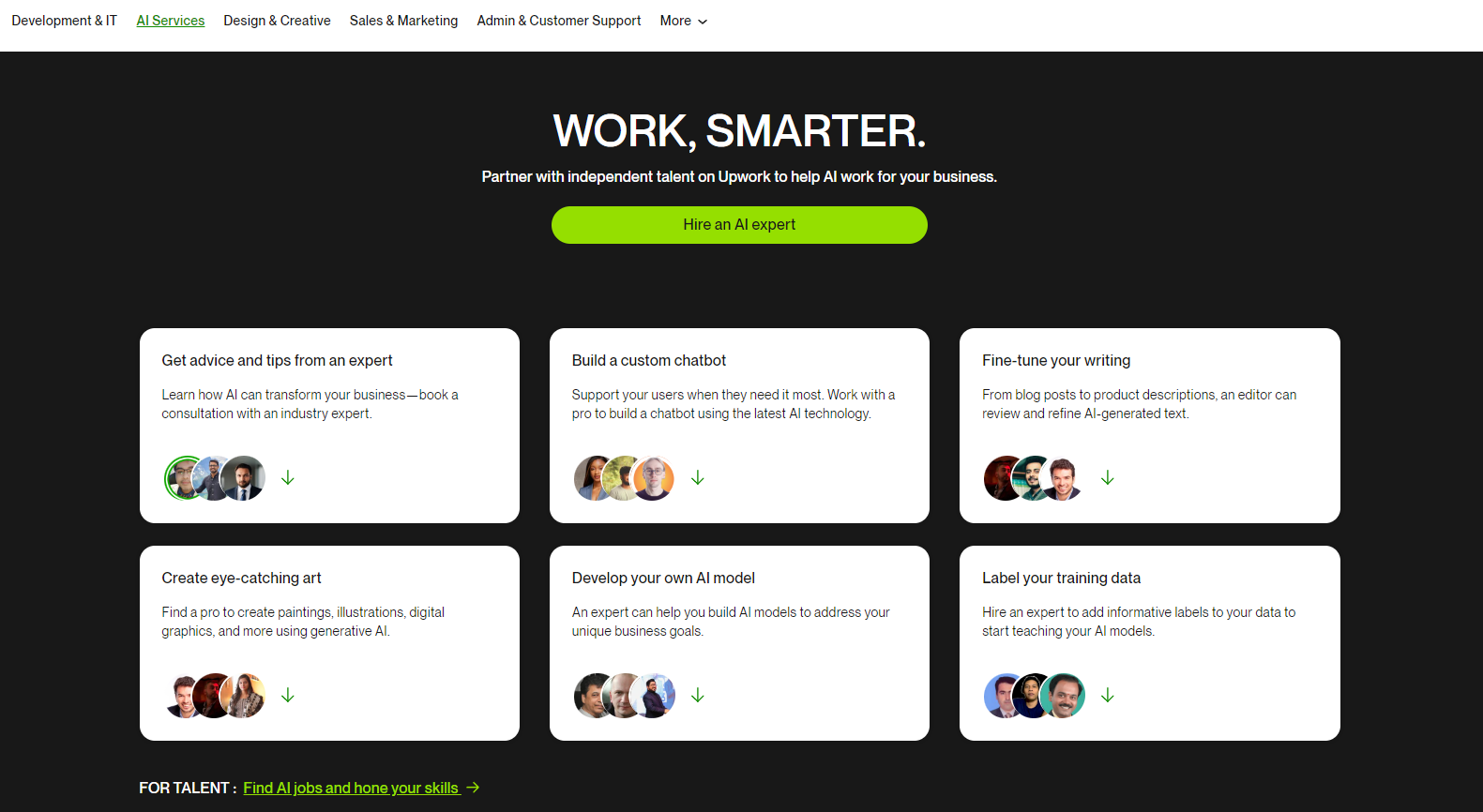
If you know your way around AI, you can take things a step further from prompt engineering and use AI to complete tasks.
Some companies already have an in-house AI expert to do this for them. But not all companies can afford to hire another employee, and so they head to freelancer and gig sites to find AI experts.
That's where you come in.
As a freelancer specializing in AI, you can use your skills to automate and complete tasks. One example is AI-assisted content editing. Another is using AI to process spreadsheets.
AI services are really hot right now, and freelancing marketplace Upwork features it as one of its top 4 gig categories.
What you need: You’ll need a deep understanding of AI programs like ChatGPT.
How to make money: List your services on digital marketplaces or freelancing sites.
How much you can make: You can pull in thousands every month if you link up with businesses in certain fields.
3. AI consultant
You can take it a step further that just offering AI services to help companies automate tasks by bringing your AI knowledge to clients in a more complete ( and lucrative) way.
A lot of businesses want to use AI, but most of them don't know where to start. As an AI consultant, you can help them figure out how AI fits into their workflow and where it can actually make a difference.
Rather than getting good at using AI to solve specific problems, for a role like this you need to assess a company runs and how AI tools can help.
One of the advantages of being an AI consultant is that you’ll be right at the forefront of AI implementation, and it’s up to you to learn everything you can about AI landscape.
That way, you can make sure that your clients are served in the best, most efficient way. And as a consultant, you can charge a pretty penny, too.
What you need: Knowledge of the AI industry and different tools out there rather than any one specific tool.
How to make money: Build your brand through content and professional networking sites like LinkedIn to find clients, and use platforms like Whop to build your consultant business.
How much you can make: As an AI consultant, you could pick up more than $100,000 per month with ease.
4. Print on Demand
Print on Demand (POD) is an extremely popular online business model, and it can make you a lot of money if done right.
But one of the main challenges with POD is creating designs that will sell.
By using AI in the design process you can easily come up with exciting designs quickly. You don't need to be an artist or designer — you just need to use the right prompts.
Whether you're making the cover for a journal, an image for a tee shirt or a couple of choice words for a mug, AI will quickly create designs that you upload to a POD platform and sell.
What you need: Generative AI tools like Midjourney to design prints, ChatGPT for slogans. You can also use AI-powered design software like Vexels if you want a premium option and more POD-specific functionality.
How to make money: List your products on online ecommerce sites and market them to relevant audiences.
How much you can make: The print-on-demand business model fully depends on how well you can market your products, so there's a pile to be made if you can do that right.
- How to edit images in MidJourney: New MidJourney feature explained
- If you want to know more about Print on Demand or just need a primer on getting started, check out our guide
- Best Print on Demand products
- Online side hustle ideas
5. Digital printables
If you like the idea of creating prints using AI but don’t want to go the POD route, you can sell digital printables instead.
Digital printables are just digital products that people can buy and then print for themselves. We're not just talking pictures. Printable digital products include calendars, wall art, coloring books, journal, checklists, and more.
All you need to do is use AI to create printables. Other than that it’s just a matter of marketing and promotion.
Influencers and big names definitely have a head start thanks to their built-in audience — but with some solid consumer research, you can carve out your own lane too. Sell them on your own website or on a platform specializing in digital products like Whop.
What you need: AI tools like Midjourney, Canva (with AI turned on), and ChatGPT.
How to make money: List your printable products on a platform like Whop where your customers can purchase and download them with ease.
How much you can make: You could make a couple of hundred dollars a month with these if you've got a small audience to sell to.
- A beginners guide to creating with Canva, from using templates to making designs from scratch
- Digital product strategy: Building a roadmap to create, market, and grow your digital product business
6. 3D modeling
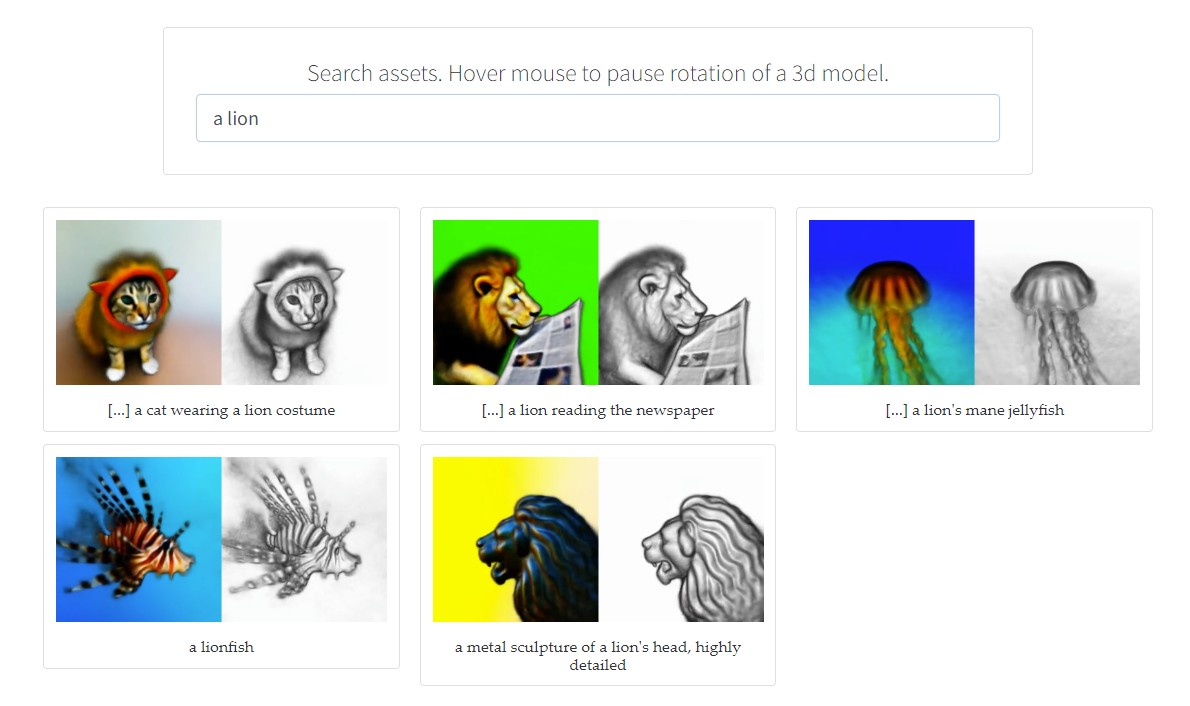
Sticking with using AI to design, you can use AI to create 3D models.
This is a big one. 3D design is a niche skill, and not many people have the expertise to pull it off, especially at the scale you’d need to actually turn it into a legit business or side hustle.
What you actually do with the 3D models is up to you. Tabletop gaming miniatures can be profitable if you’re know of what you can and can’t do from a licensing perspective, and you could set yourself up to design and print pieces for up-and-coming board game designers.
Text to 3D is still an emerging area, and Dreamfusion is one of the best options out there currently. It’s still in development, but as the technology matures you’ll be able to do more and more with it!
What you need: Text to 3D AI tools like Dreamfusion.
How to make money: Either create bespoke 3D designs as a freelancer or set up your own 3D printing business.
How much you can make: If you're able to find the right niches, you can charge a premium and make plenty of profit.
7. Sell PLR digital products

Private Label Rights digital products are digital products that are created by one person and then distributed by another. People buy PLR digital products and edit, rebrand, and sell as their own.
It’s an easy way for businesses to grow without doing all the work — they outsource design and product creation to digital creators, who often earn good money for it.
So, where does AI come in? Well, as you should know by now, creating digital products is something that AI can do quite well, if you’re good with prompts.
With the right tools of choice and prompts you can create digital products in minutes rather than the hours, days, or even weeks it might take to make them from scratch.
Then, package the products up as a PLR bundle and sell them over and over again.
What you need: Generative AI tools like ChatGPT and Midjourney are the standard although it depends fully on what sort of digital products you decide to create.
How to make money: Sell your PLR digital products to bigger brands or influencers.
How much you can make: If you have a ready audience to sell to, PLR digital products can boost your income by hundreds every week.
8. Coding
You could say coding is just how humans tell computers what to do — so it makes sense that AI can play a huge role here, helping you write code faster and smarter.
There's a wide variety of tools that can help you complete programming tasks easily.
In fact, AI coding tools are becoming standard practice in the development industry already, helping to improve productivity and accuracy, translating between programming languages, finding code snippets, and even auto-generating documentation.
But AI coding tools aren’t quite there when it comes to being completely safe. Studies have found that software engineers who use AI tools are more likely to see security vulnerabilities.
This means that you probably shouldn’t trust AI to get all of your coding done blindly, but rather use it to pad out and make your own work more efficient.
What you need: GitHub’s Copilot is one of the best, but OpenAI’s o1 is also very worth a look.
How to make money: Sell your coding skills as a freelancer and tackle paid programming tasks.
How much you can make: Coders can make absolutely obscene amounts of money, and enhancing your ability to code with AI isn't going to hurt your ability to do so.
9. Chatbot development
Chatbots have been around for years, to the point now that it’s almost engagingly impossible to get human customer support contact for online businesses.
That means any business using — or thinking about using — a chatbot on their site is a potential opportunity for someone with dev skills.
Pair that with the need for improved conversations and more sophisticated functionality and you’re talking about AI-driven chatbots.
Developing robust AI chatbots could be a huge opportunity with a practically never-ending list of potential clients. Sure, big companies are already in the game, but not everyone’s nailed it. There’ve even been cases where people tricked chatbots into giving out free stuff.
That might sound like fun PR, but it’s a nightmare if your bot keeps getting exploited. Create chatbots that are safe, glitch-free, and built with a focus on great user experience, and you’ve got something seriously valuable.
What you need: AI coding utilities like as GPT o1-mini or Copilot, although assistants like Claude could also help. You’ll also want to look into chatbot frameworks such as Microsoft Bot Framework or Rasa.
How to make money: Design and sell AI-powered chatbots to firms as software.
How much you can make: Many businesses and smaller internet sites will pay up to $10,000 for a fully functional chatbot.
10. AI trading bots
Trading bots are another type of software that have been around for a while, but AI could really shake up what’s on offer.
Quite simply, AI has many advantages over the traditional algorithmic trading system — including the amount of information it can process, the variety of activities it can perform, and machine learning.
An AI-powered bot can crunch financial data in real time, handle all the calculations you need, and keep track of the bigger picture at the same time.
Machine learning can also help a trading bot to analyze data patterns and draw inferences from them, adapt to changing market conditions and respond to opportunities or threats without explicitly being told to.
So if you've got an understanding of AI and trading, then put the two together and give investors the smartest tools they could ask for to strike gold.
What you need: AI coding utilities such as the ones previously mentioned.
How to make money: Get listed on Whop’s trading page and sell your AI trading bot there.
How much you can make: You can sell subscription access to a solid trading bots for at least $100 per month per customer.
11. SaaS
It should come as no surprise that the SaaS industry is already very much in bed with AI.
Software-as-a-Service is a business model that has an unprecedented level of growth and scale, with all of using using SaaS in our lives in some way.
Use Netflix? Then you're using SaaS. Make work calls with Zoom? You guessed it — SaaS.
Now, SaaS companies are using AI to improve user experience. Netflix uses AI for content recommendations. Zoom uses AI to improve video quality and cut down on background noise within video calls. Slack uses an AI-infused chatbot — Slackbot — to handle repetitive tasks.
So, there are plenty of opportunities to make money with SaaS and AI. A good place to start is to scroll back up and check if any of the earlier ideas match your AI skills and interests in the SaaS world.
Or, given how much time and effort AI saves in the coding and development process, you could create your own SaaS startup with AI.
If you think developing an entire SaaS project or app using AI is a bit of a reach, just check out Blake Anderson’s story. Spoiler alert, the sum of money involved in the tale is truly mind blowing.
What you need: Depends on what opportunity you intend to explore.
How to make money: Bootstrap your own SaaS venture and develop it quickly using AI, either as a standalone service or for other companies to enhance their own products or productivity.
How much can you make: A successful SaaS venture could set you up for life, and even one that only picks up a few customers could still earn enough cash to pay for itself and even fund your next project.
12. Sell AI courses
There are two side-hustles here — first of all, you can teach courses in AI once you develop the skills to actually make a side hustle out of any of the previous ideas.
For example, let's say you master AI and prompt creation. You’ll find that plenty of people are hungry to learn those same skills. So, sell your skills to them with a course.
Secondly, you can also use AI to actually create courses. It doesn't matter what the subject is, some AI tools can help you structure and edit your course, while others can help with touching up and graphics.
You can also get simple animations and text-to-speech made for small instructional videos with AI, meaning that your actual workload is reduced and your courses pay a whole lot more compared to how much they cost to build.
What you need: ChatGPT for brainstorming and course structure, Midjourney for design and Descript to create videos.
How to make money: Sell your courses on a digital marketplace or a top course platform like Whop.
How much you can make: A well-marketed course could easily add another four figure item to your monthly incomes.
13. Resume writing
Today, most companies use programs to screen resume, filtering out ones that don’t meet their criteria or don’t have the right keywords.
The makes it difficult job seekers to get seem. Some don't know how to work the system, and others spend a huge amount of time and money on applications just to have them thrown out without reaching human eyes.
You can use your AI skills to help here. There are specialized AI tools like Novoresume that’ll do the job, but even ChatGPT can be given a job listing and a candidate’s basic resume as inputs, and spit out a tailored resume as an output in a matter of seconds.
More advanced AI tools will also use the right templates and formats for the task, making sure that the resume reading programs used by hiring firms can process everything properly.
How do you make money? Offer your AI-powered resume-writing services on any online gig platform or freelancer marketplace and expect to charge up to three figures a pop, depending on the sort of jobs people are looking at.
What you need: ChatGPT for basic resume generation, tools like Novoresume if you want to take it to the next level.
How to make money: Sell your resume writing and optimization services on freelancer marketplaces.
How much you can make: Job seekers will pay up to $100 for a really effective refresh of their resume.
14. Websites and landing pages
Websites and landing pages are key to ecommerce, and the demand for web design services continues to grow.
There are a bunch of services that offer quick and easy building of basic web and landing pages, but for businesses and entrepreneurs who want to go the extra mile, you can offer your services.
Start by using AI to create web templates. Then, once you have a client base, move onto bespoke web design services.
You can whip up inspirations, alter them, and even embellish them just the way you want in minutes with AI tools.
What you need: Canva, Midjourney, and other design-based AI utilities.
How to make money: List templates on digital marketplaces before starting a web design business on Whop.
How much you can make: You should be able to pull in well over $100 per landing page you set up for clients.
15. Stock images
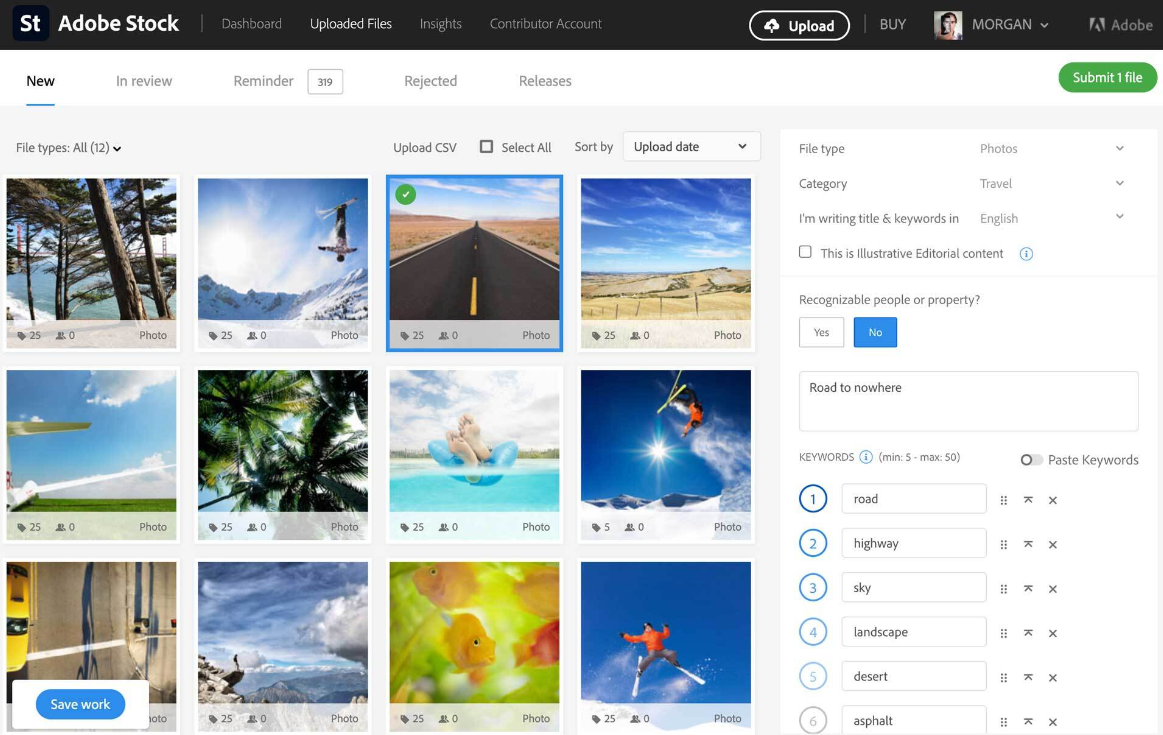
Typically, stock images have been created by professional and hobby photographers. Now, some stock image websites have started selling AI-generated content.
A quick word of warning: By selling AI-generated art on a platform like this you’re opening yourself up to liability if you cross certain boundaries, so stay clear of copying other work.
Plus, when selling stock AI art, don’t expect to sell pieces for lots of money. It’s going to be a matter of quantity rather than quality since the only real work you put in here is typing in a prompt.
What you need: Image generators like DALL-E and Midjourney, with the latter being most creators’ tool of choice.
How to make money: Sell your stock AI generations on platforms like Adobe Stock which allow AI-generated art. Some platforms, including Adobe Stock, also have their own image generators.
How much you can make: You might be able to make $5 on average per AI-generated print that you sell.
16. Content marketing
If you’ve got skills in writing or marketing, you can start making money by offering content marketing services — and AI makes it way easier to scale.
Tons of small businesses, creators, and brands want to grow through content but don’t have the time or skills to do it themselves. You do.
With AI tools like ChatGPT, you can quickly generate blog post drafts, landing page copy, newsletters, or even scripts for YouTube and TikTok. It saves you hours of work and lets you take on more clients without burning out.
That said, you still need to bring the human touch. Google ranks content based on quality — stuff that shows real expertise, experience, and trust. Fully AI-written content usually won’t cut it.
So use AI to build the structure, pull in research, and speed up your workflow, then go in and polish it up with your own voice and strategy.
Let AI save you time, but don’t rely on it to do everything for you if you want the best results.
What you need: Text generation tools such as ChatGPT and Jasper.
How to make money: Offer content marketing services to businesses. Use AI to create blog posts, website copy, newsletters, and more. You save time, deliver fast, and help clients grow through SEO and content.
How much you can make: Rates vary, but freelance content marketers typically earn anywhere from $100 to $1,000+ per project.
17. AI-generated newsletters
If you didn’t already know it, newsletters are one of the hottest sources of revenue today.
In the past newsletters were considered just a marketing tool, but now creators (and businesses) alike are using newsletters to make money with subscription fees, affiliate marketing, and sponsorships.
So, why not allow AI to create your newsletters for you? There are AI newsletter generators that scan for whatever content exists in a given niche, then include the most relevant of it into your newsletter.
These AI newsletter programs can then learn about user preferences as they go to start adapting content to suit certain audiences, and require minimum input from you.
You’ll still need to jump in and edit to make sure your newsletter actually delivers value, but that’s nothing compared to writing and pulling it all together from scratch.
What you need: CleverReach and Piktochart AI are specialist tools for newsletter content generation, but many LLM’s can get the job done in a pinch.
How to make money: Either release a free newsletter and direct readers to your other digital products, sell ad space, or charge a subscription fee for your newsletter.
How much you can make: Subscription newsletters can make you thousands a month even with a super cheap fee, as long as you attract plenty of readers.
18. Faceless YouTube videos
Faceless YouTube channels are a great way to make money online, and AI makes it incredibly easy to create faceless content.
You will need to use a few AI tools here. Let Jasper write the script, then feed that into Fliki or Lumen5 to get a video that you can tweak.
Then, you can earn money on YouTube by uploading these videos consistently. It may take some time to get started, but stick with it and you can start making decent income.
What you need: Jasper can help you create scripts and structure stories, ChatGPT is great for brainstorming, Synthesia can add voice to text you write, InVideo can suggest stock video for your script, and Descript makes editing easy.
How to make money: Generate platform revenue with services like TikTok and YouTube, and monetize your community through further side hustles as well as subscriptions and memberships with Whop.
How much you can make: Just like with a normal YouTube channel, you can start off with around a $100 per month with a few videos a month and the minimum monetization threshold.
19. Faceless TikTok videos
Much like faceless YouTube videos, faceless TikToks are also a thing.
The how-to for a faceless TikTok is much the same as with YouTube. A smart text-generating AI tool can do up the script for you, and then it’s about running it through a video generation AI like Fliki to conjure up some visuals to go with your script.
Then, a text-to-speech AI like ElevenLabs can take care of the audio side of things, before you finally put it all together with AI-enhanced video editor Descript.
Doing faceless and either mostly or even fully AI-generated videos on TikTok might be an even better bet than on other platforms, because the way users interact with TikTok is quite unique.
AI can help you to catch them at first glance, and then the message of your video can take over. You’re catching viewers with their guard down, whereas with platforms like YouTube you’ve got to really compete for attention and appeal to their intelligence.
What you need: There are plenty that can get the job done, but for example a combination of Jasper, Fliki, ElevenLabs and Descript can get an entire video project done from scratch.
How to make money: Check out this guide to monetizing TikTok content.
How much you can make: If you rely on ad revenue TikTok can be quite limited, but faceless videos plus the TikTok Shop could make for a cocktail that brings you upwards of $1000 per month.
20. AI podcast
If you like the idea of faceless media but not video content, then try audio.
Podcasts continue to be incredibly popular, and you can use AI to help create your own podcast. We've already outlined a number of tools that could do the scripting for you, but it may be better to write out the script yourself and have AI refine it.
Where AI really comes to the party is with its text-to-speech capabilities. A tool like Descript, which we've featured previously in this list, could do it all for you, from the voice to the editing and post-production too.
What you need: A text-to-speech and editing AI to mix up the audio for you, as well as a tool like ChatGPT to do the scripting or editing.
How to make money: Sign up with a top podcast monetization platform to get the cash rolling in.
How much you can make: You could make up to $500 per month with a moderately successful AI podcast.
21. Transcription
Transcription is usually a freelance gig needed by researchers who have a large number of interviews but don’t have enough (or any) assistants to convert all of that speech into text.
And it’s not just the sciences — many companies are researching, and they don’t always have enough interns for the job!
This fuels the need for freelance transcriptionists. And with AI the job can get a whole lot easier. There are a number of AI tools that do text-to-speech really well, and while they’re not perfect, a single pass by a human is all that’s usually required to have a final, clean version.
Descript, which we’ve mentioned as a video editing AI, actually does transcription as a first step. If you record using it, it transcribes whatever you say and then allows you to edit video via the script.
The same goes with importing audio. The AI will transcribe it, so you can even make a nice, cleaned-up and enhanced version of the recording once you’re done transcribing.
There are also a few specialist transcription AI tools.
Whisper is well known as an accurate option for Mac users, TurboScribe can help you transcribe fast at very low cost, and Notta tends to be a good option for transcribing group conversations like meetings and focus groups since it has speaker identification.
What you need: Transcription AI like Whisper, Notta, or TurboScribe although a more versatile option like Descript works too.
How to make money: Offer transcription services on freelancing platforms or via your own site.
How much you can make: You might look to make around $20 per hour doing traditional transcribing, but AI will help by massively upping your efficiency and letting you take more gigs in the same amount of time.
Make money with AI and Whop
There are endless ways to make money online, and AI is just making it easier. Whether it’s speeding up your workflow, unlocking new skills, or creating totally new opportunities, the tools are right at your fingertips.
Now that you’ve seen how simple it can be, why not start creating your own products? Courses, consulting services, digital downloads, PLR content — you name it, you can sell it.
And when you're ready to sell? Do it on Whop.
Whop is the easiest way to launch, manage, and scale your digital products, with everything from payments to fulfillment built in.


